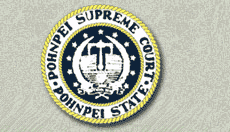CODE OF THE
STATE OF POHNPEI
2012 EDITION
(ADVANCE COPY)
_________________________________________
INTRODUCTION
The year 2012 edition of the Pohnpei Code is the most recent publication of the codification of the laws of Pohnpei State to date since the establishment of constitutional government. This publication was authorized by the Pohnpei Codification Act of 1988, which was preceded by a numb er of acts that date back to the 1976. This Code is based upon the Ponape District Code of 1971, the Trust Territory Code of 1980, public laws enacted by the Ponape District Legislature and legislatures of the state of Pohnpei through January 8, 2012.
The inclusion of laws from the Code of the Trust Territory of the Pacific Islands (1980) stamps the jurisdictional authority of the state of Pohnpei firmly within the boundaries of the Constitution of the Federated States of Micronesia and the Constitution of the state of Pohnpei. The laws that derive from the Trust Territory Code have been updated so that references to governmental authorities of the executive, legislative and judicial branches of Pohnpei State now make sense in the context of state constitutional government.
The organization of the Pohnpei Code generally follows those established by other jurisdictions. However, its divisions and titles reflect the unique scope of legislation of the state of Pohnpei. It has been set out so as to ease research and reference as well as its primary purpose of codifying the public laws, exclusive of appropriation laws and acts either obsolete or of a temporary nature.
The source of laws have been provided for all sections, extending as far back as the Ponape District Code of 1971 and the 1966 edition of the Trust Territory Code, as well as public laws of the Ponape District Legislature from 1970. There have also been included extended legislative history notes and general notes to enhance research of original legislation. Tables have been provided so that the user may find the placement of specific sections of public laws within the Code or to confirm the omission of public laws from within the Code.
All public laws that are found within the Code, and the prior Ponape District Code provisions and Trust Territory Code provisions that make up the Pohnpei Code were first readopted and reenacted as positive law in the comprehensive codification statute of 2006, (S.L. No. 6L-79-06, 11/1/06) and have thereafter been updated through January 8, 2012. Therefore, all future laws of the state of Pohnpei that amend, supersede or repeal laws within the Code should be enacted as provisions of the Code. A program of annual updates is envisaged to keep the Pohnpei Code current with legislative changes.
The Pohnpei Code is the product of a team effort of the entire Legislative Counsel Division of the Pohnpei Legislature over a period of many years. Each member of the team contributed significantly to the final production of the Code, and words of appreciation are extended for their persistence and demand for perfection throughout the years that the Code was under construction.
These individuals include the Division lawyers and paralegal staff who researched and compiled the massive collections of district, state and territorial laws for inclusion in the Code, the code editors who were largely responsible for the structuring of the Code in its printed form and who acquired the technology necessary to produce the Code in its digital format, the proofreaders whose eyes for detail ensured the accuracy of the Code in both the text of the law and its references, and the Division secretaries who undertook the arduous task of converting statutory laws into code language.
Table of Contents:
|



